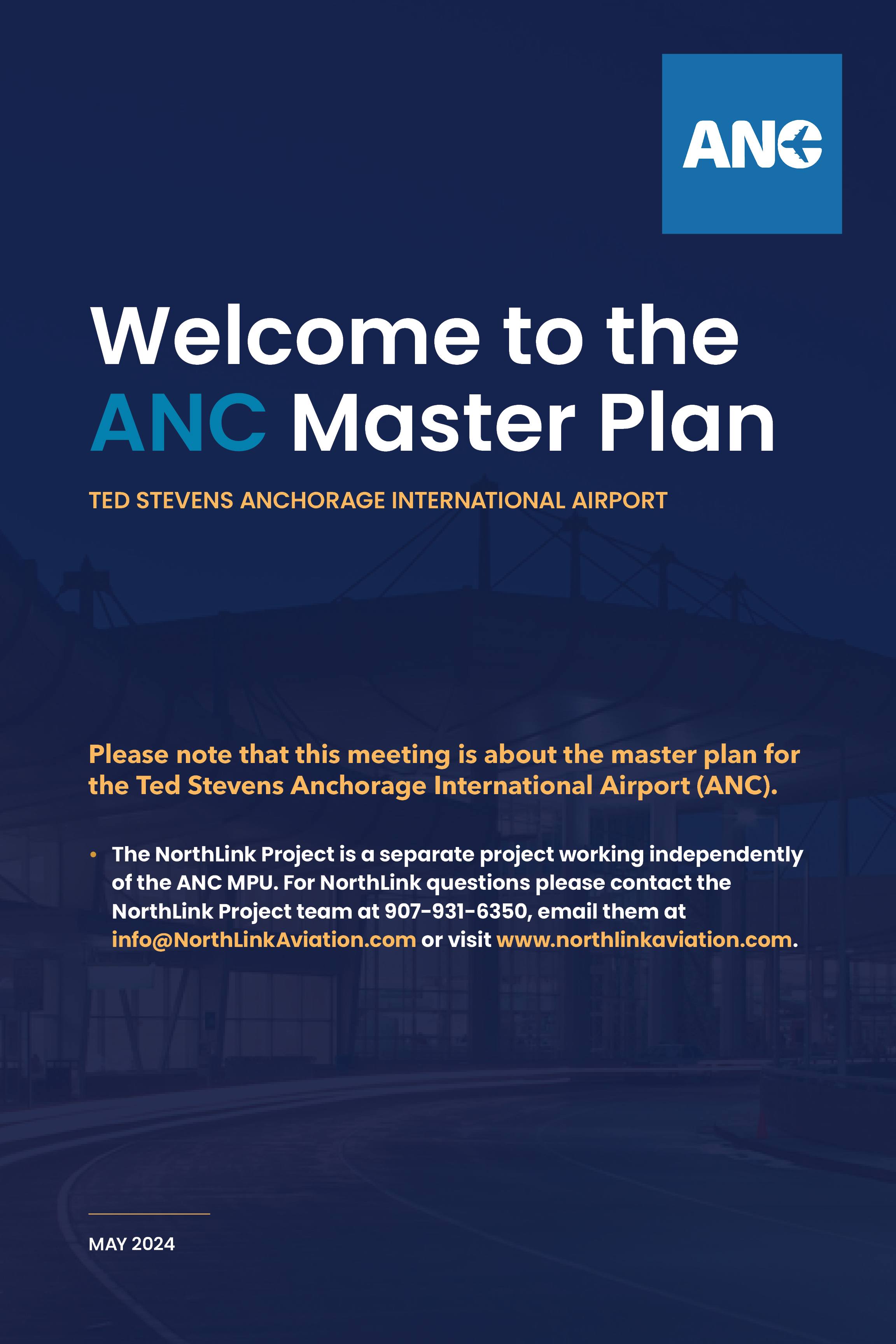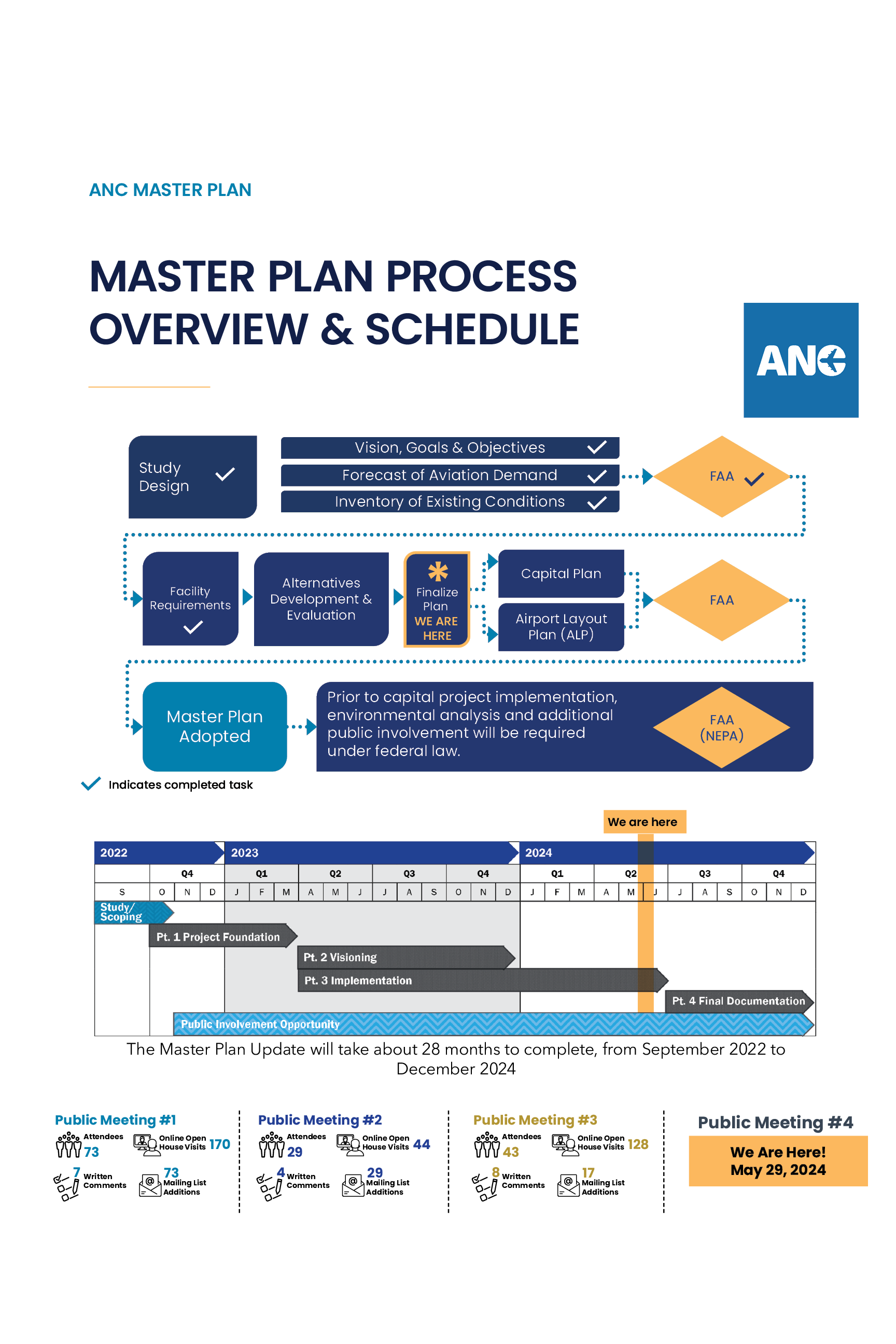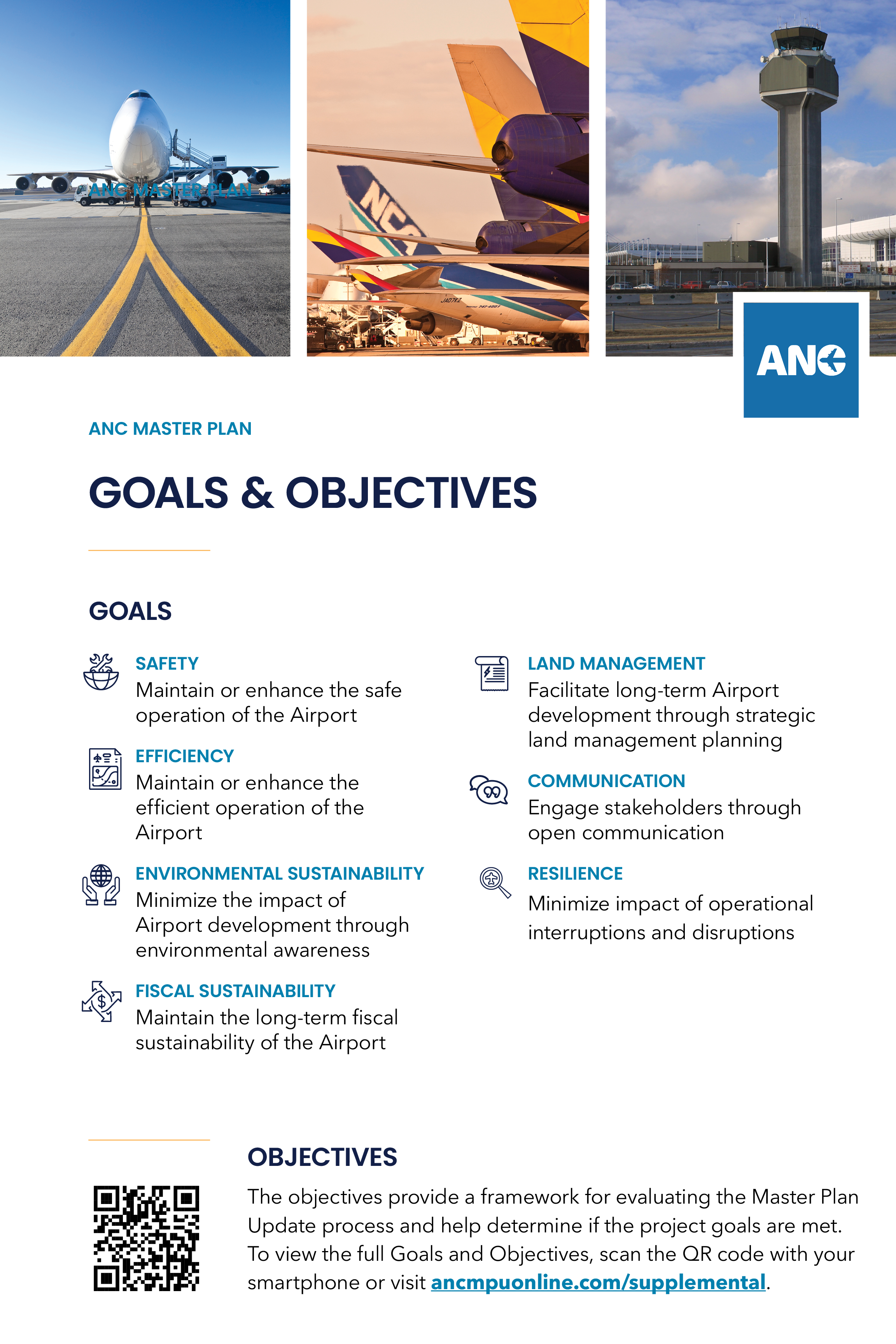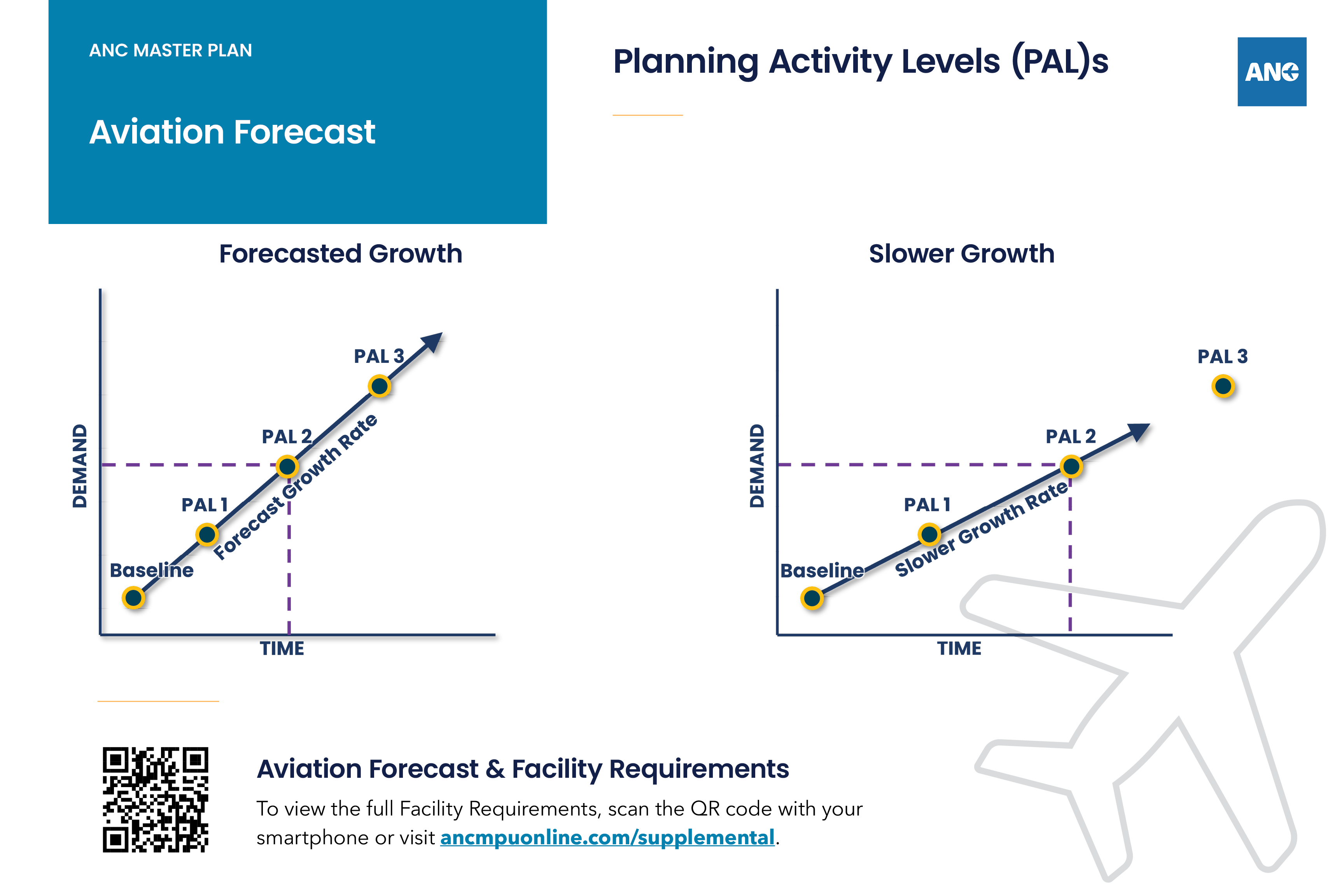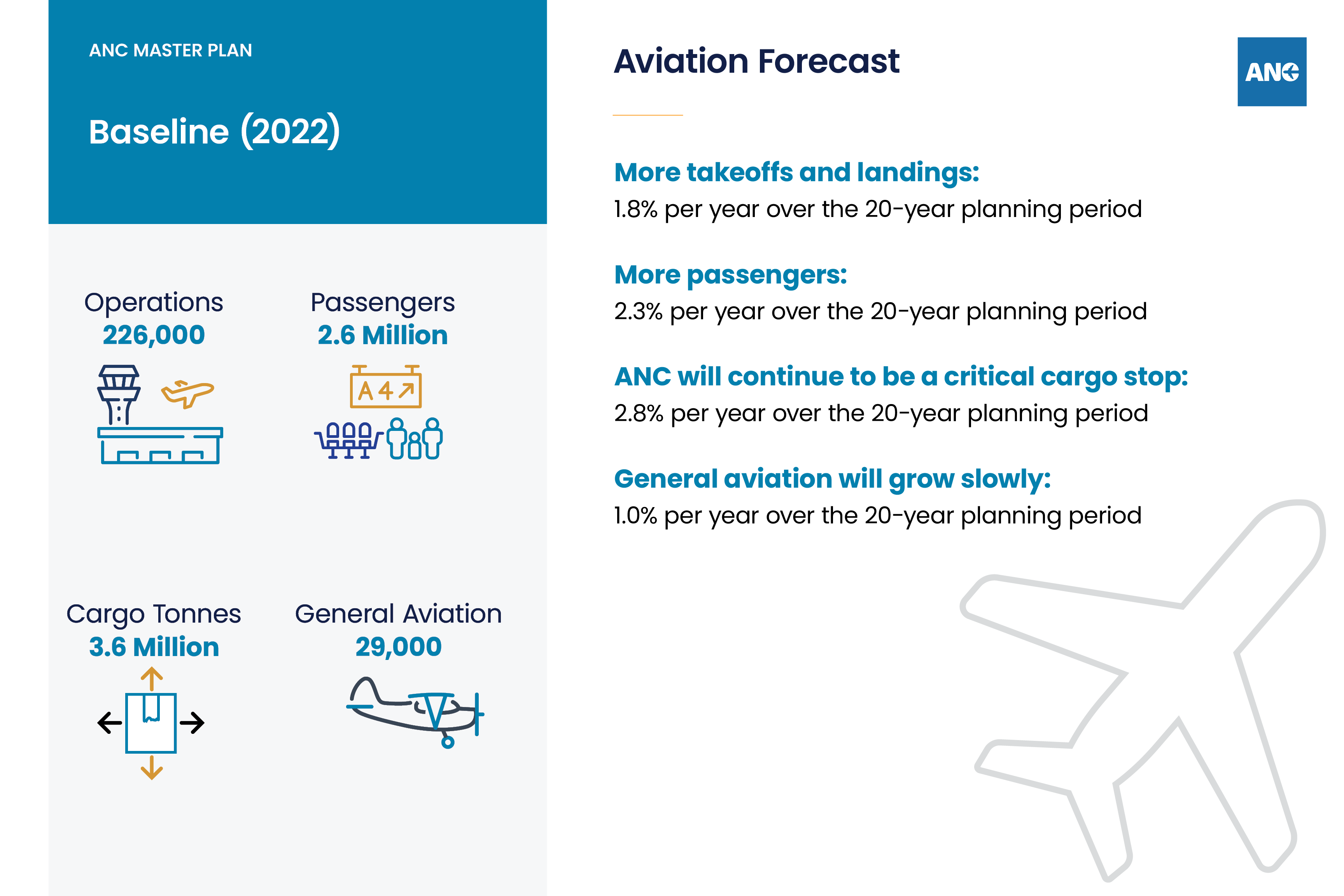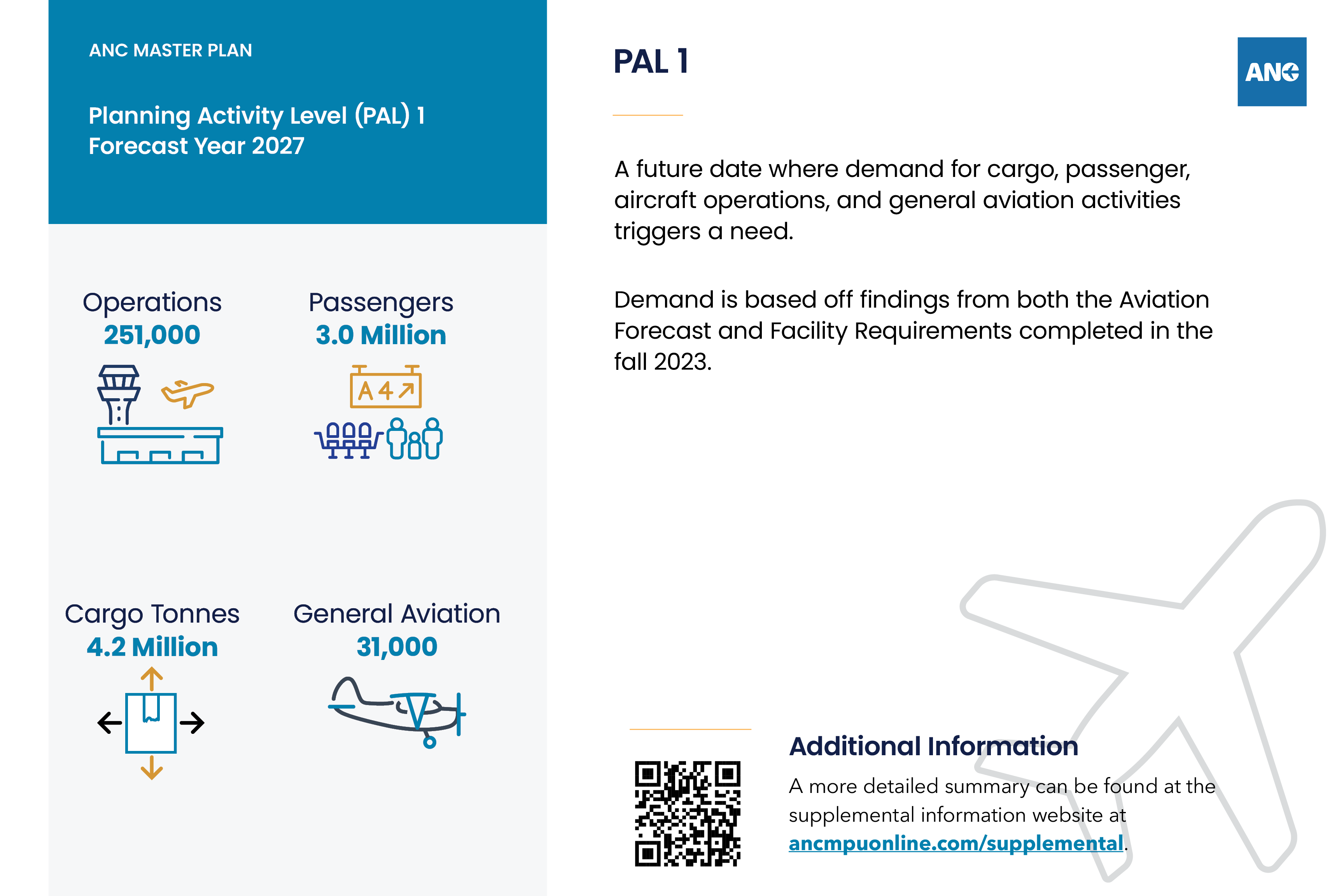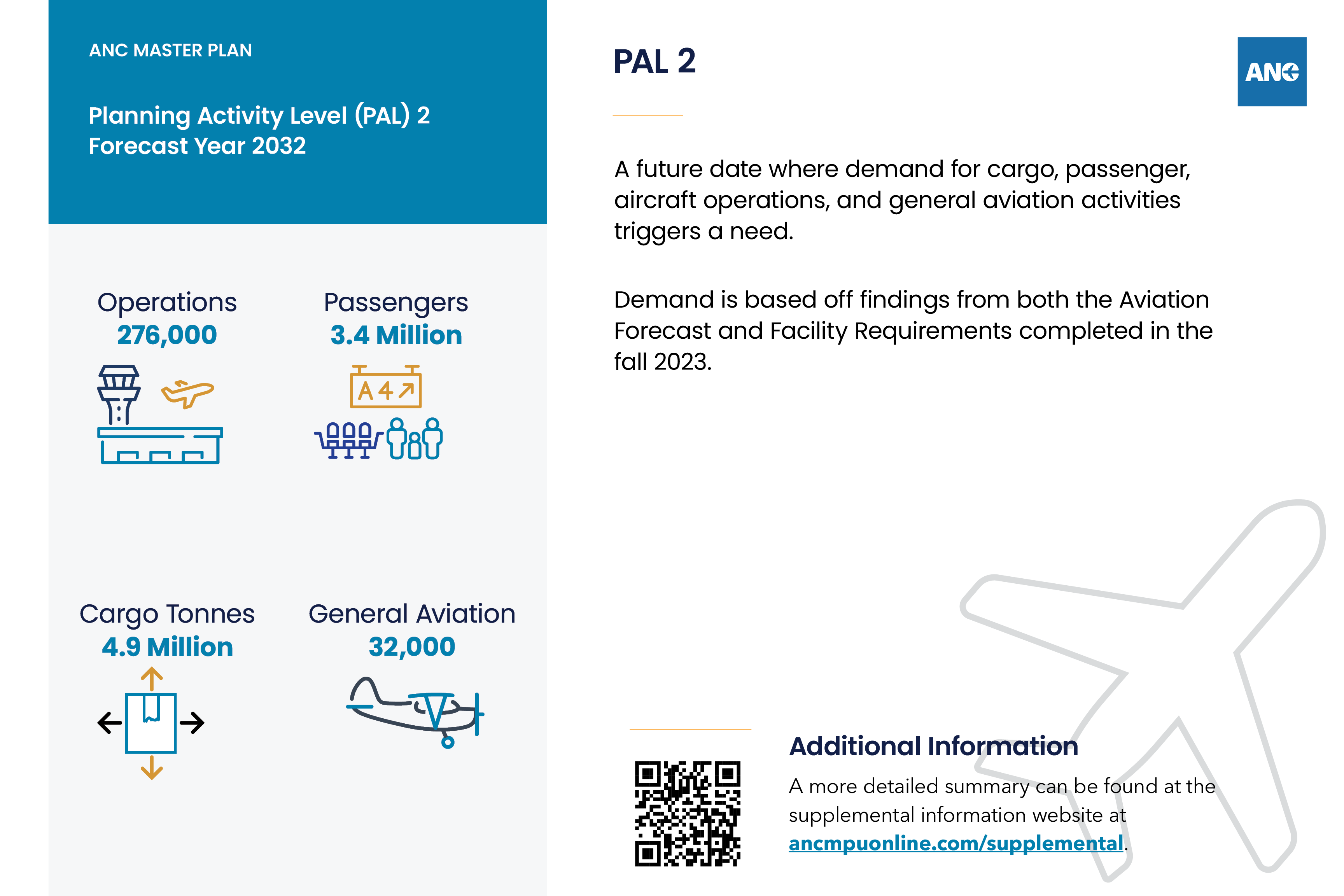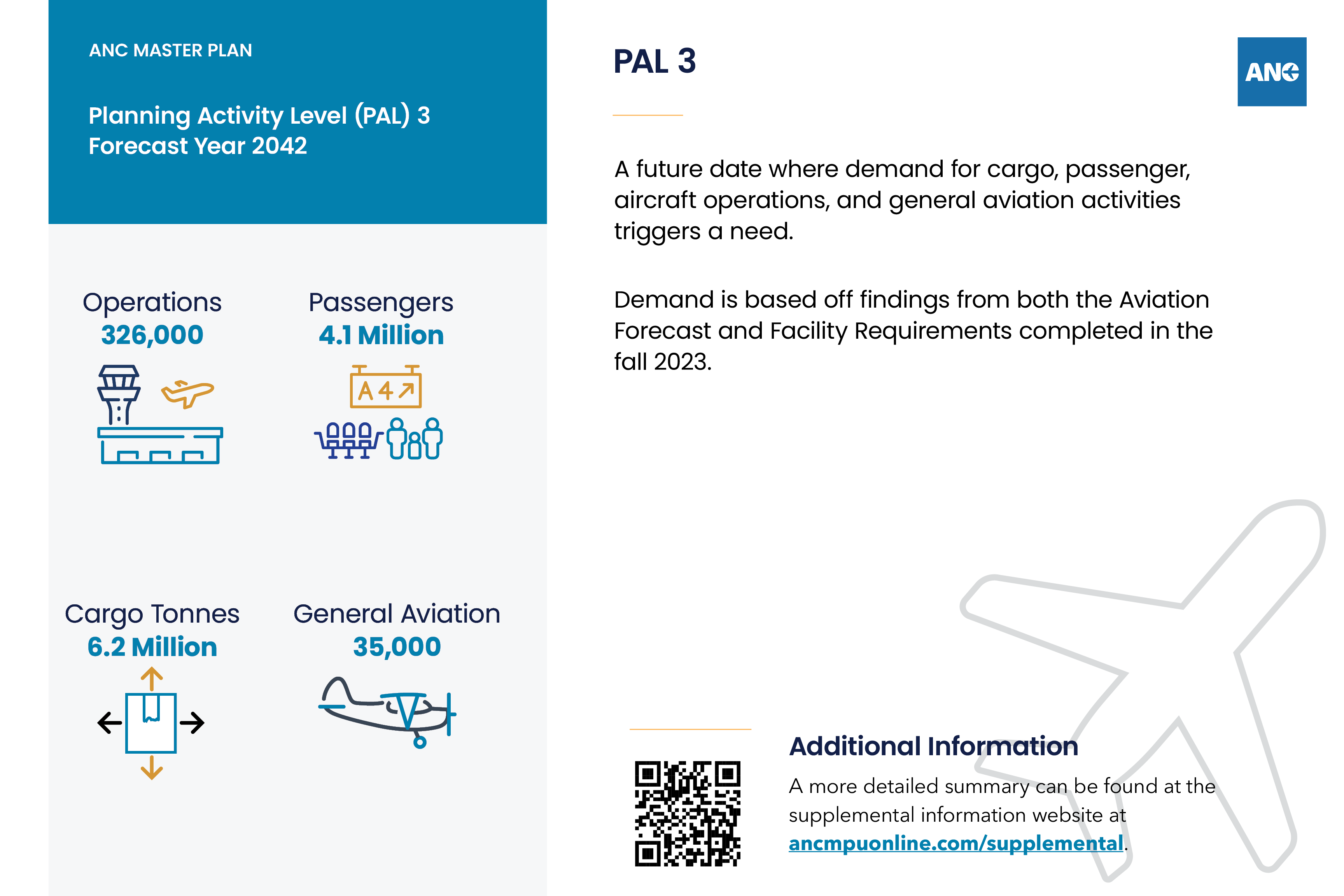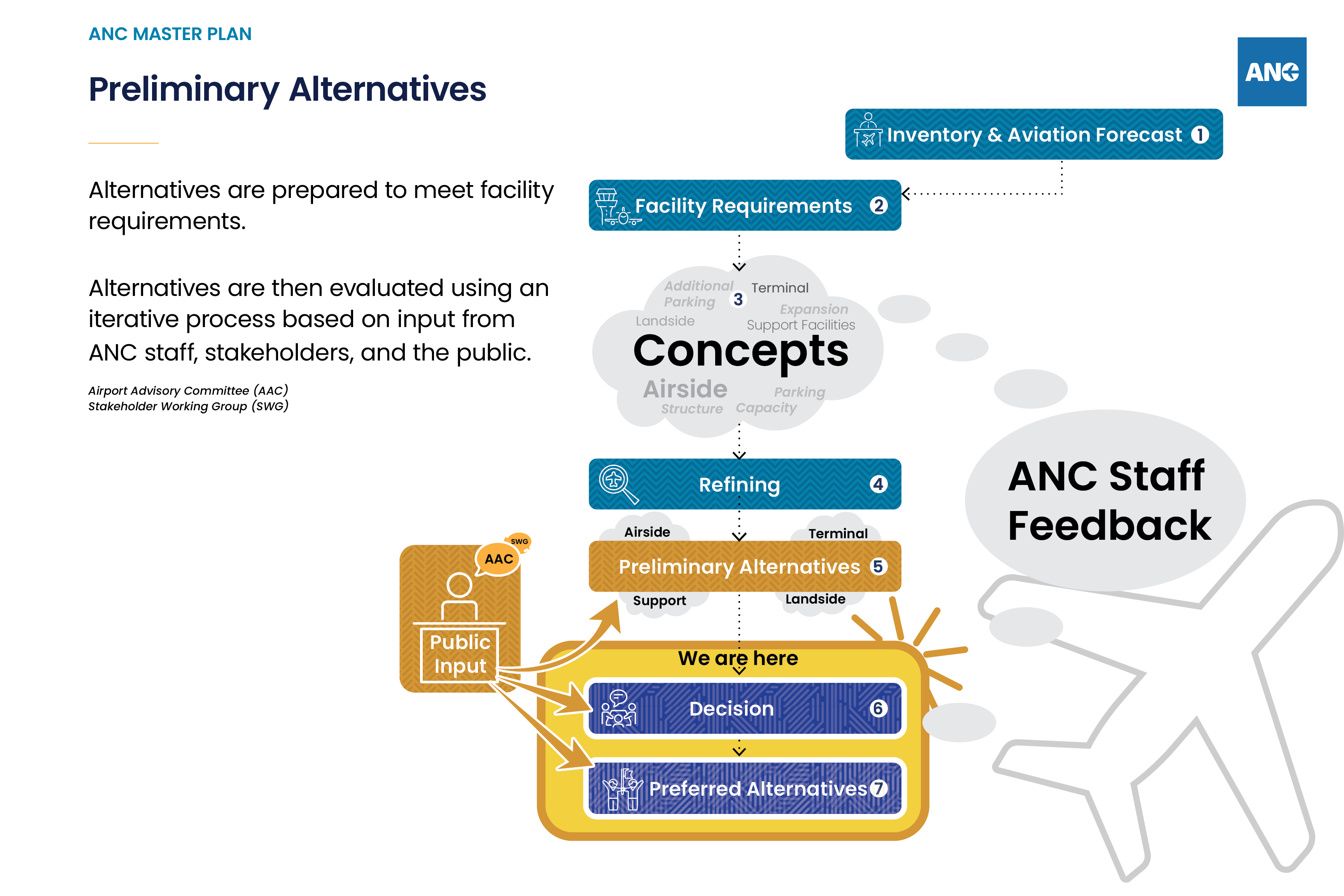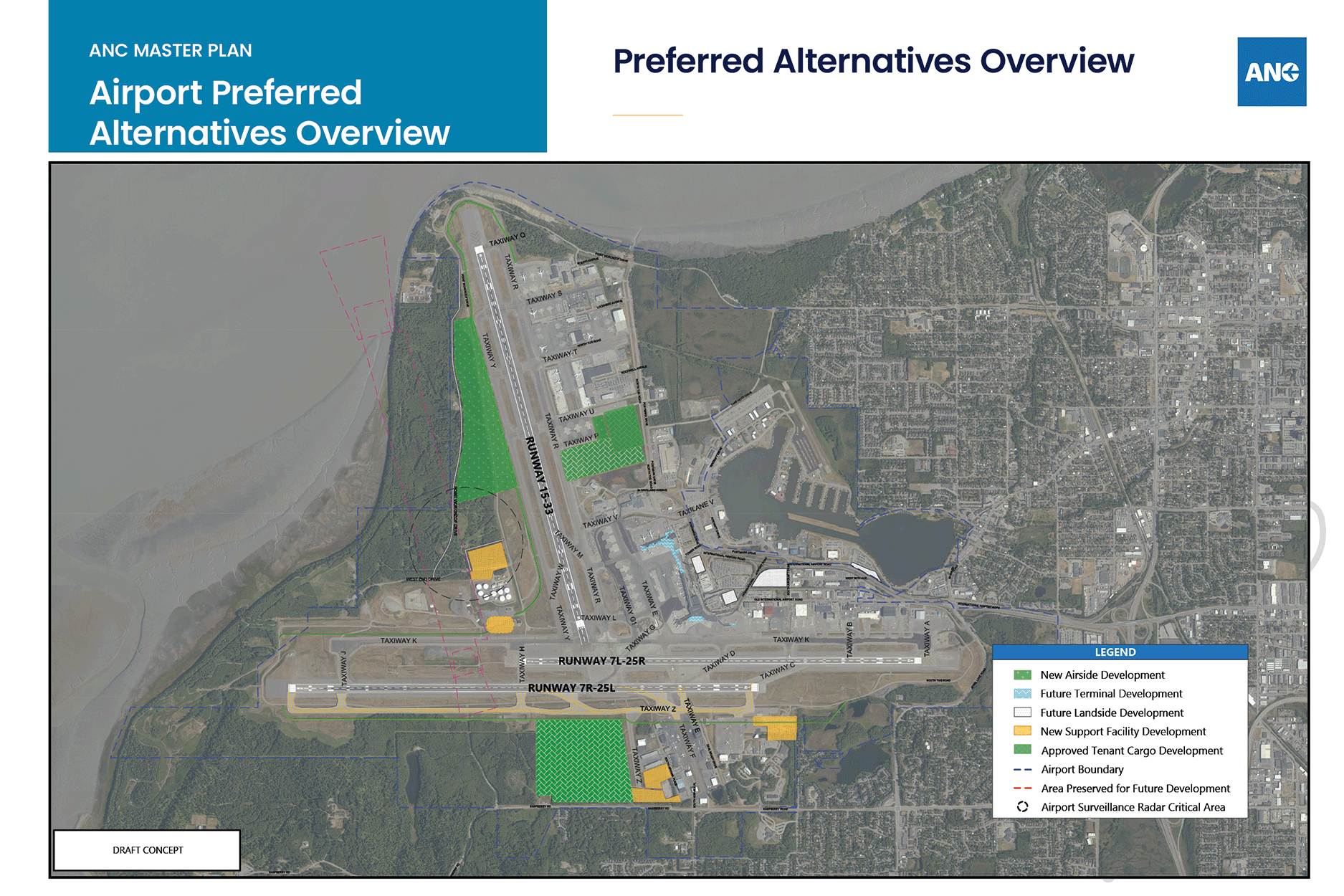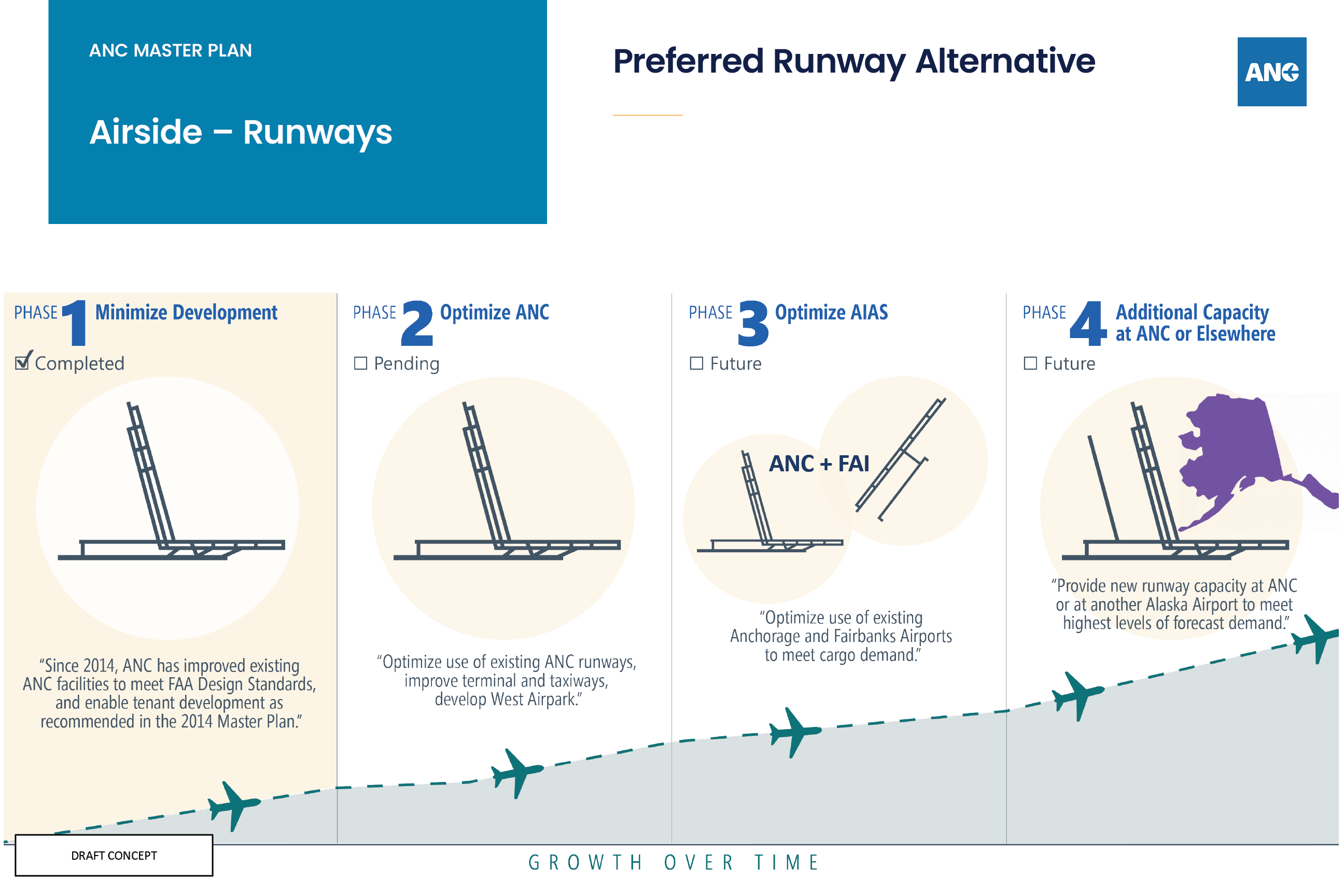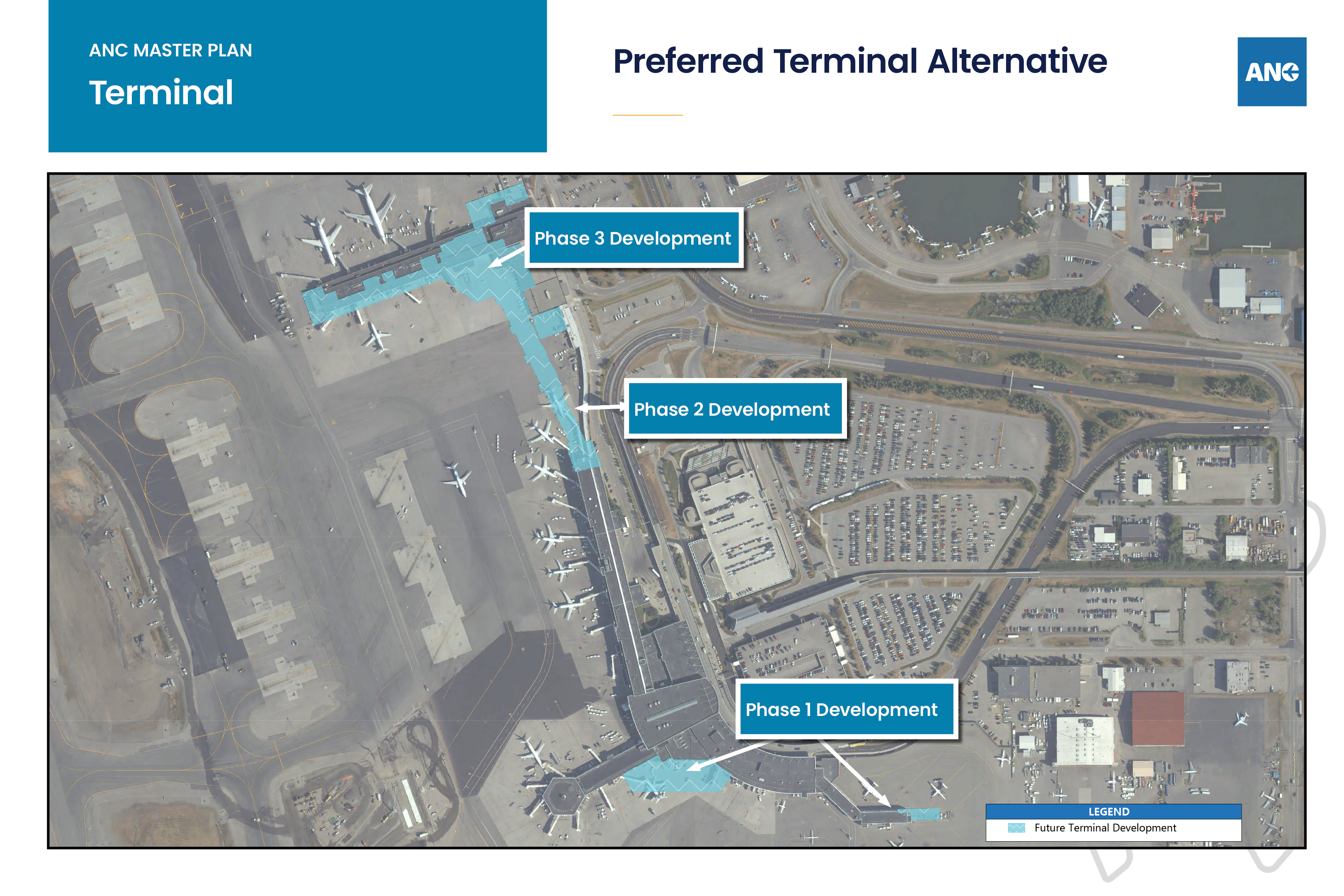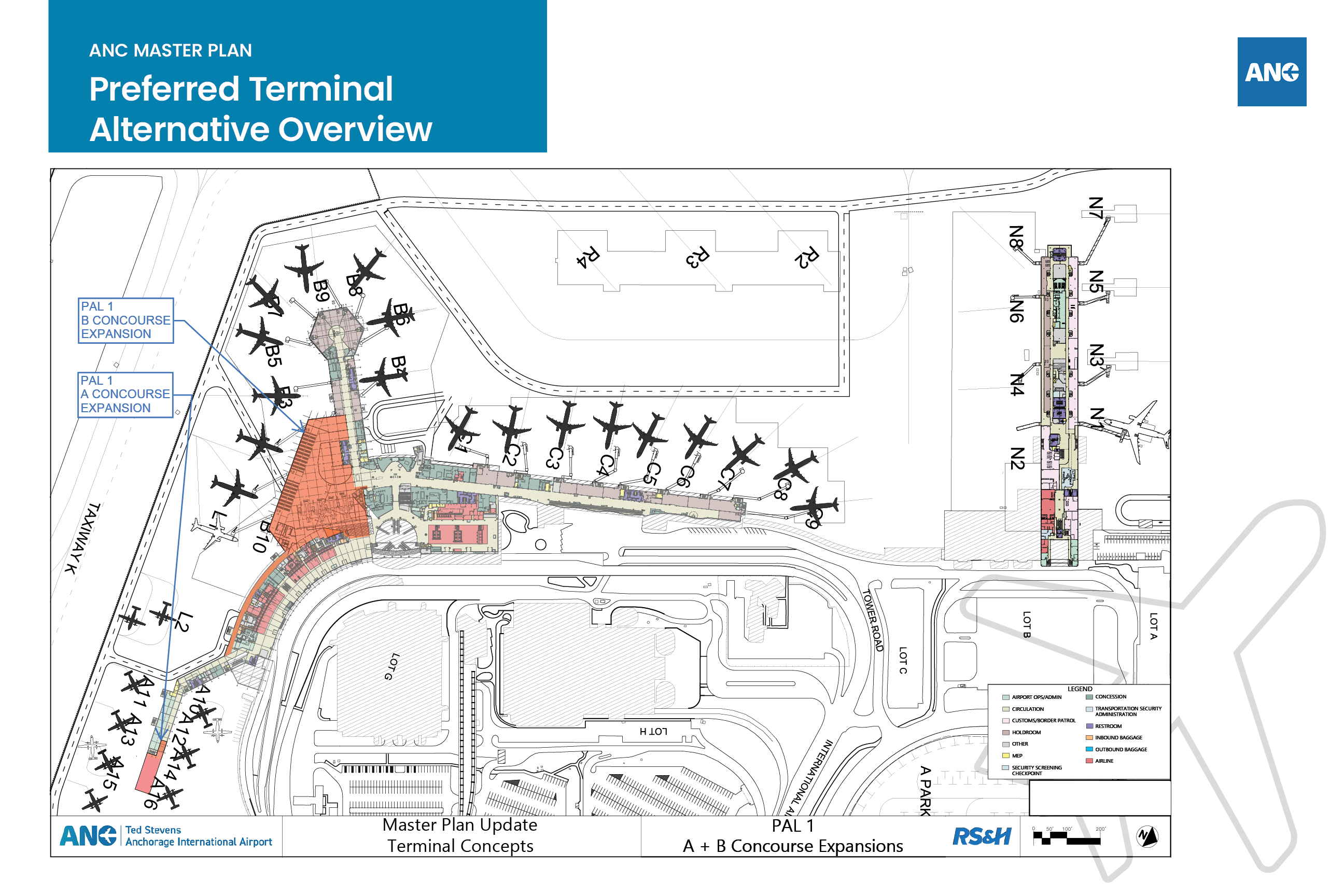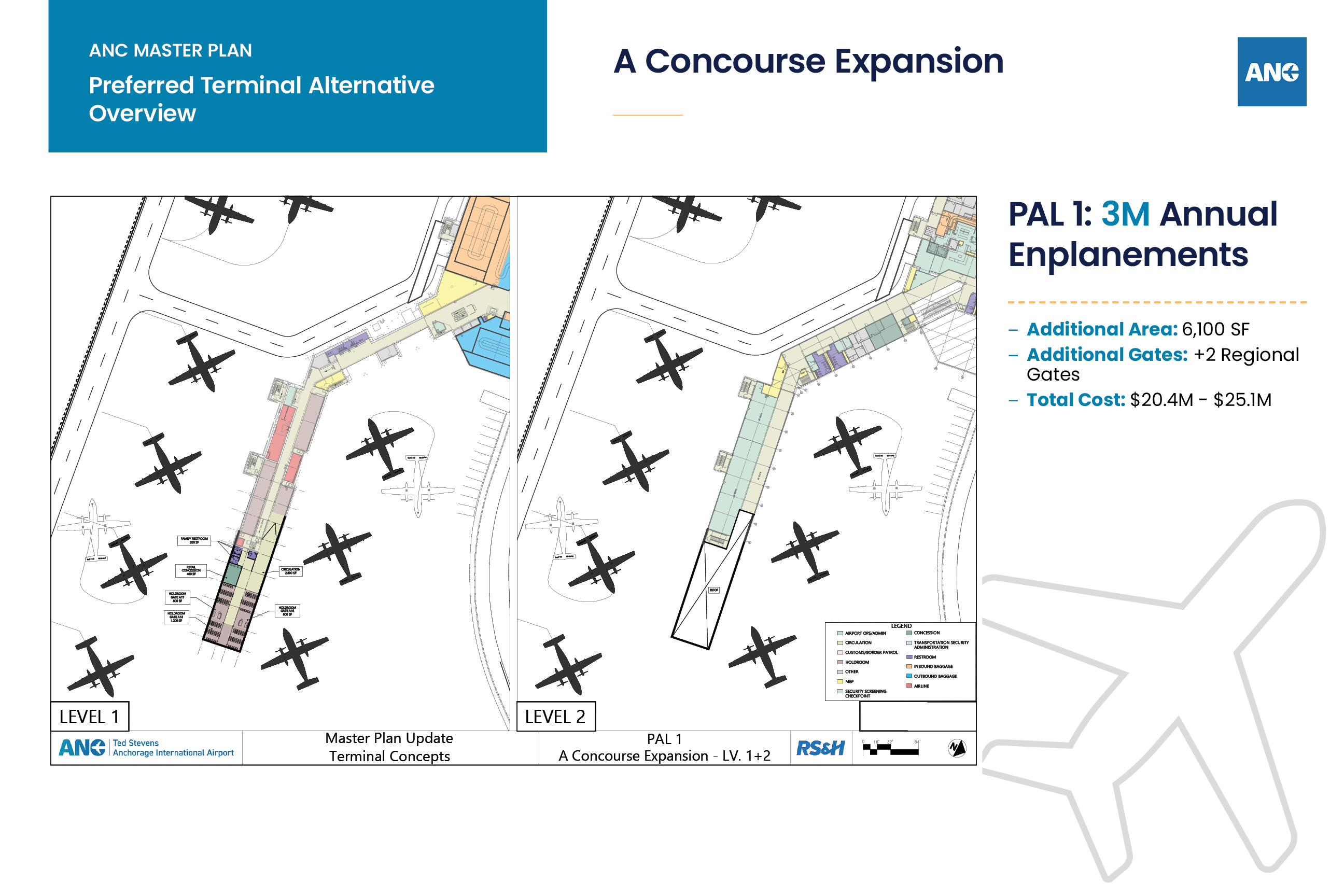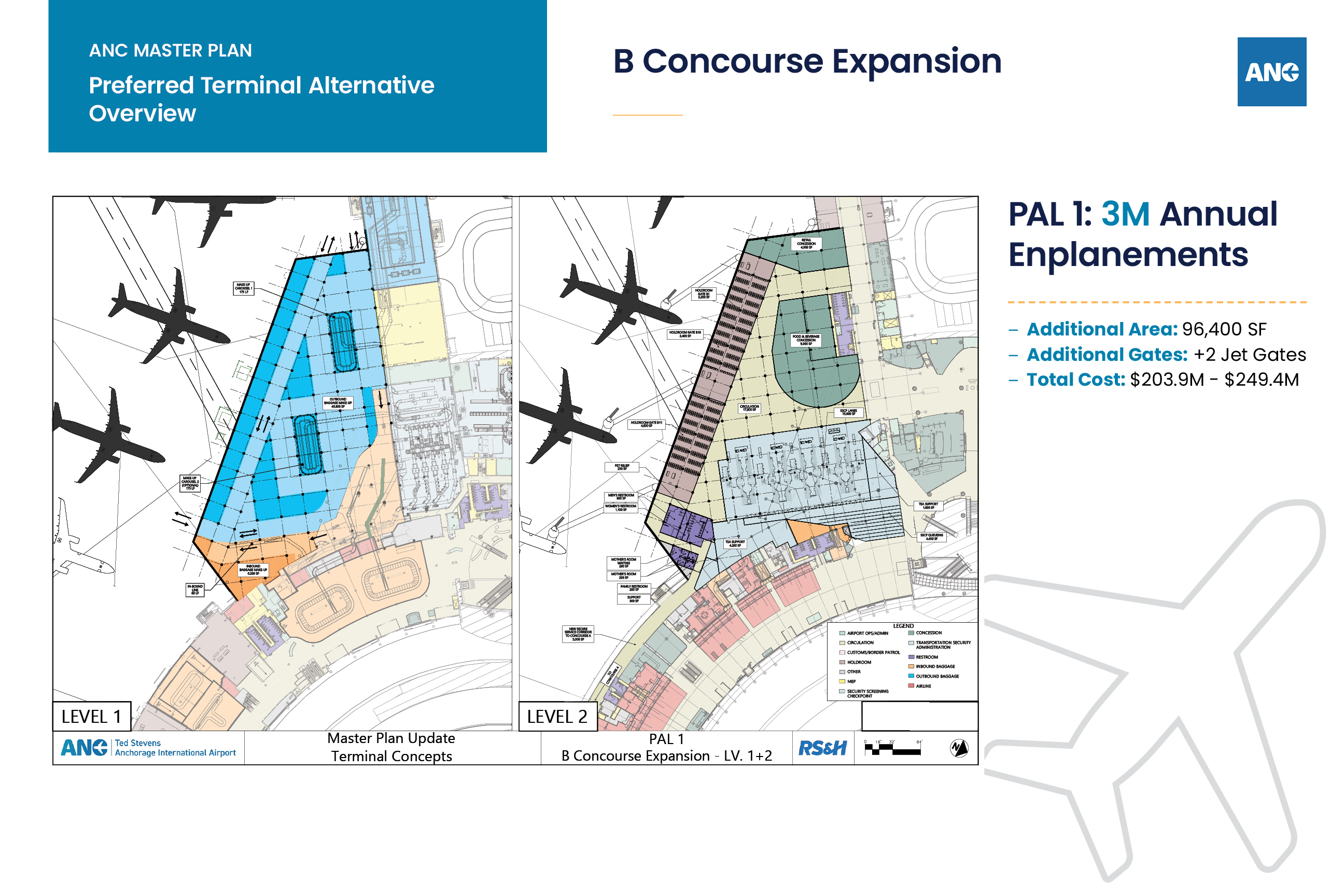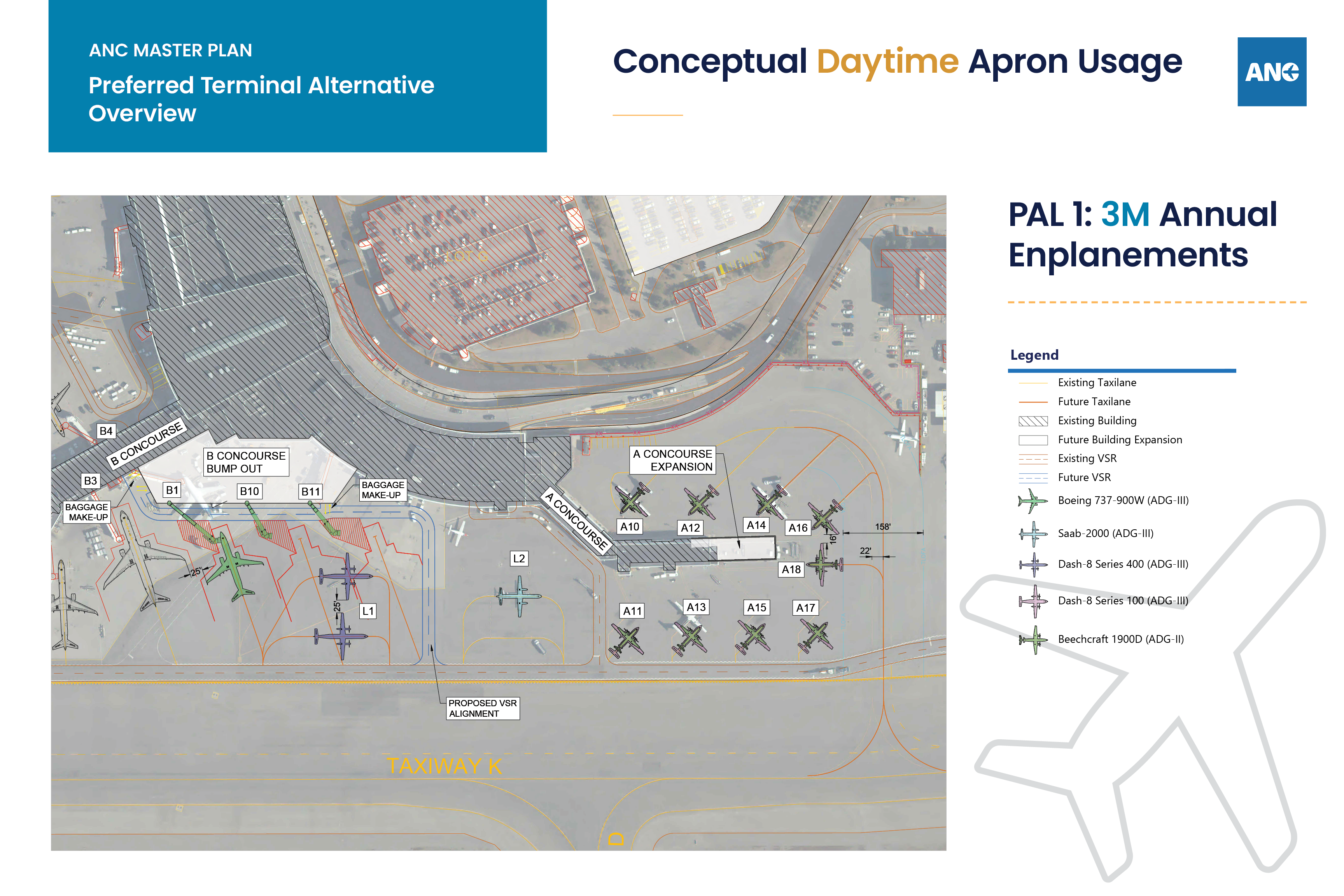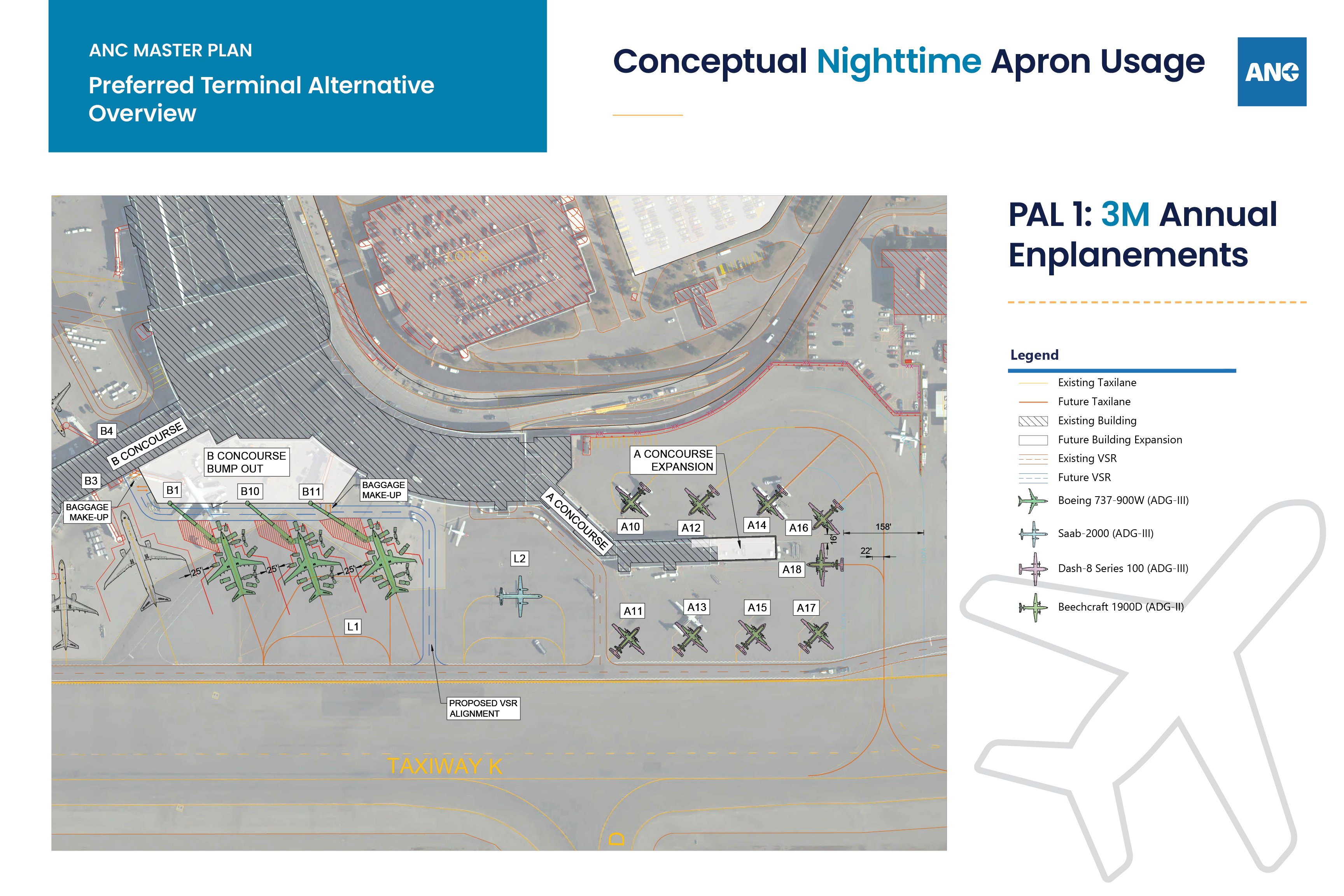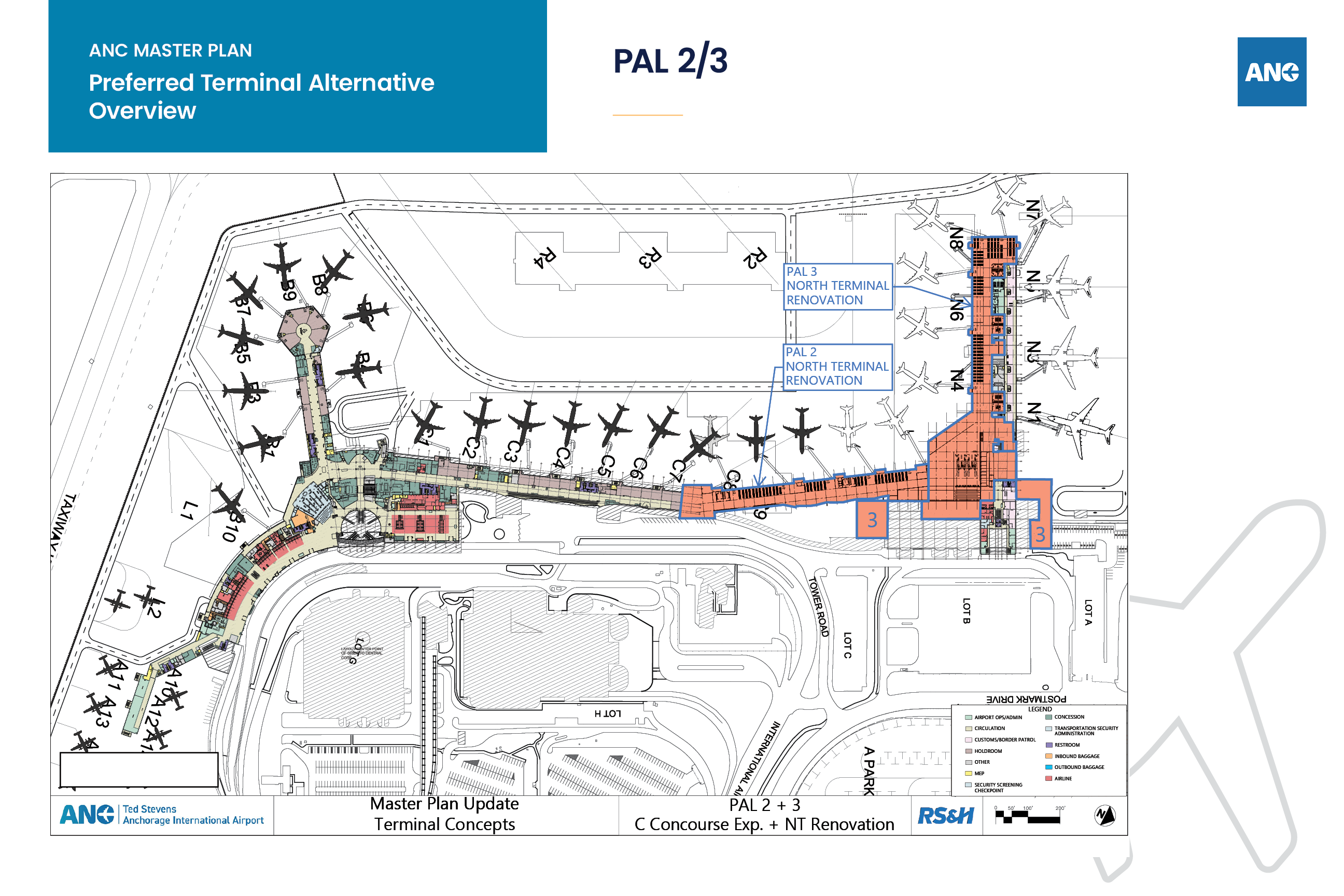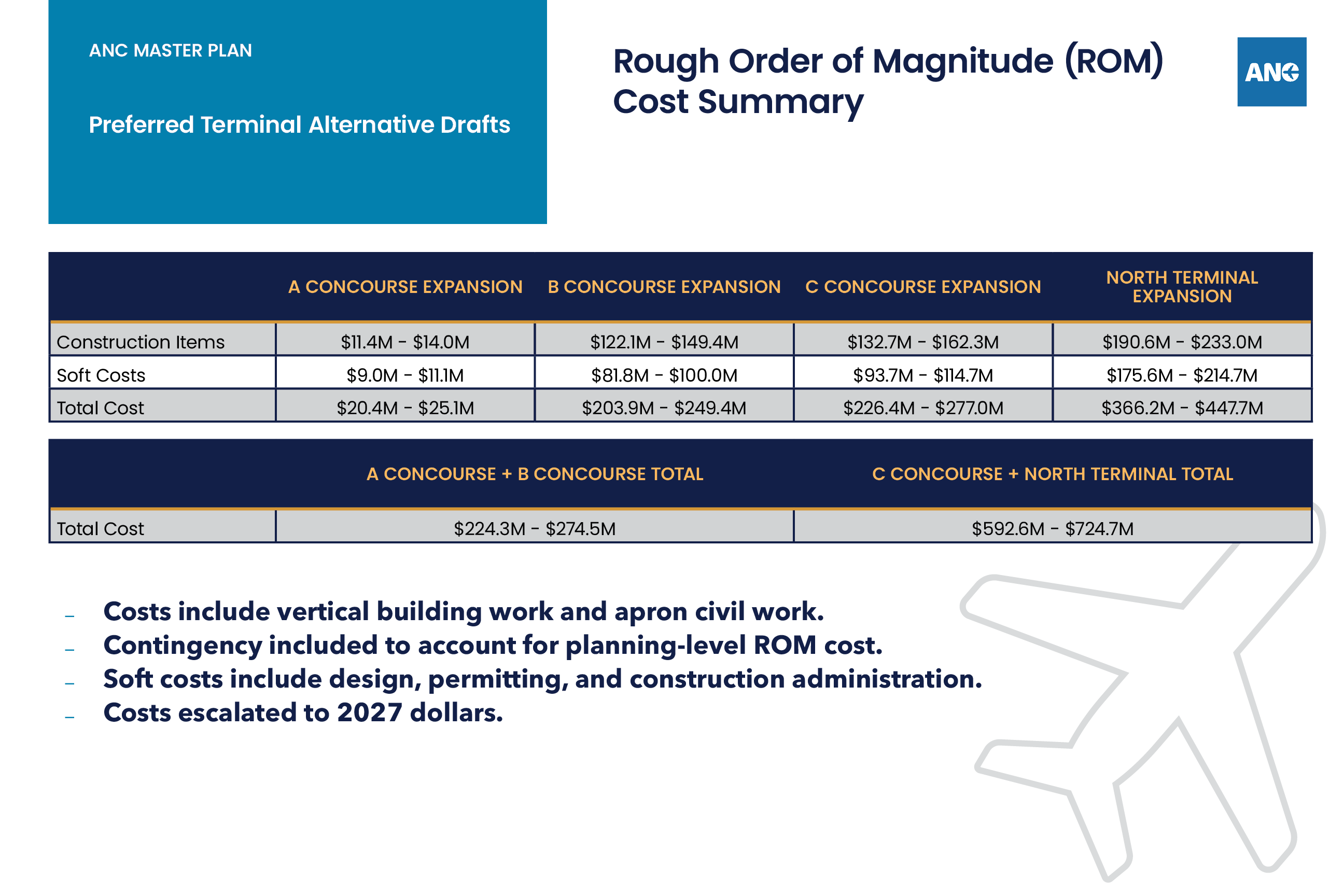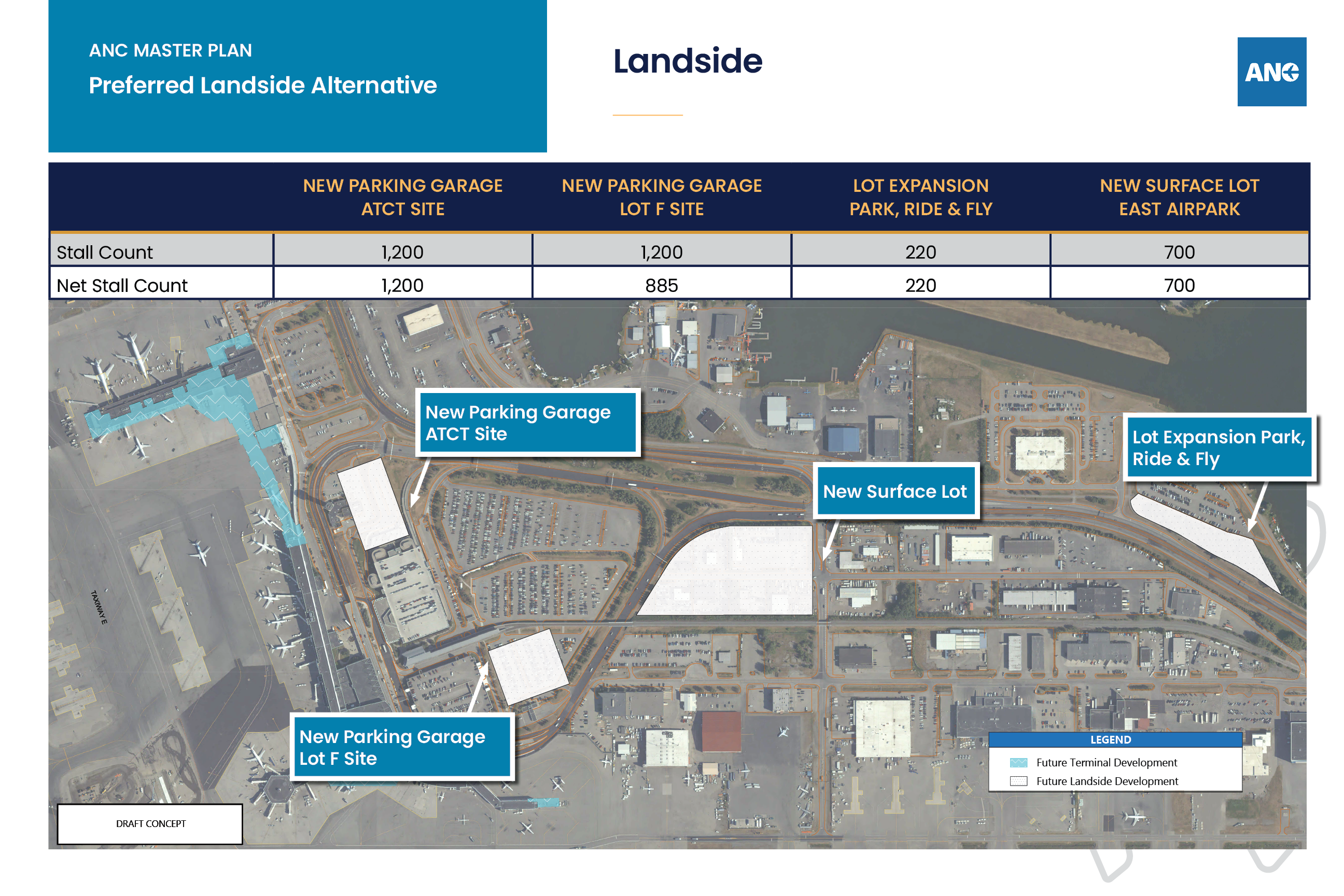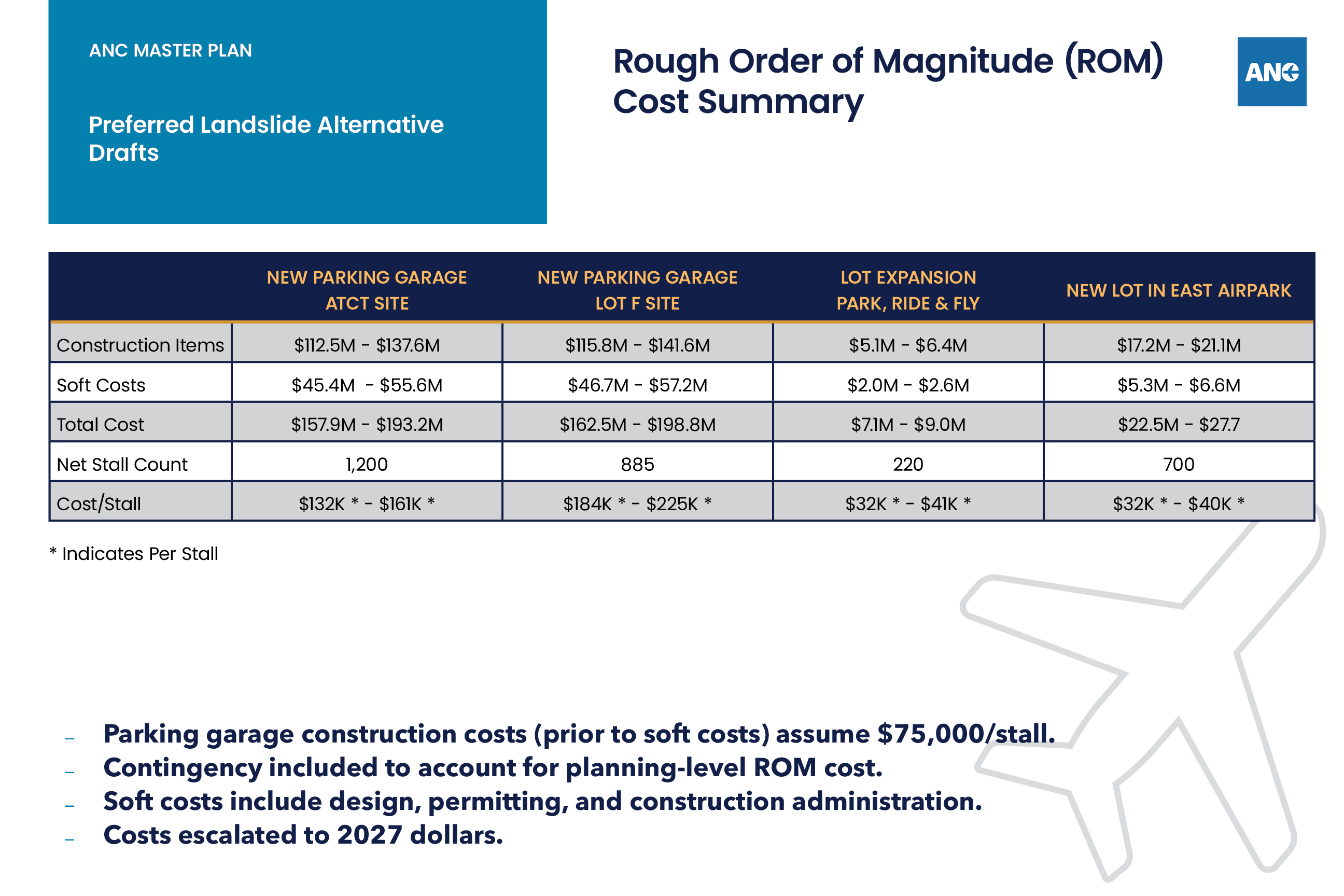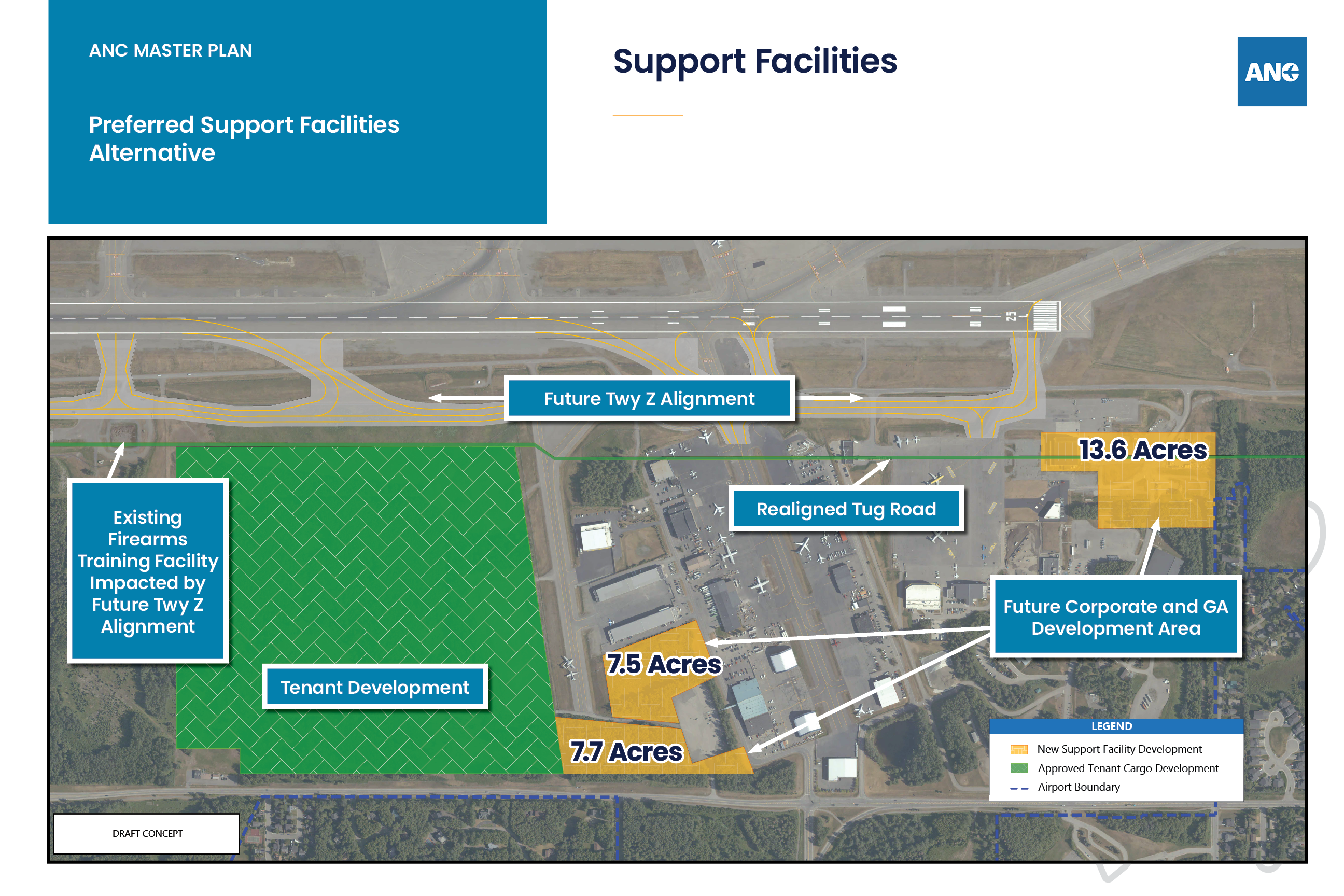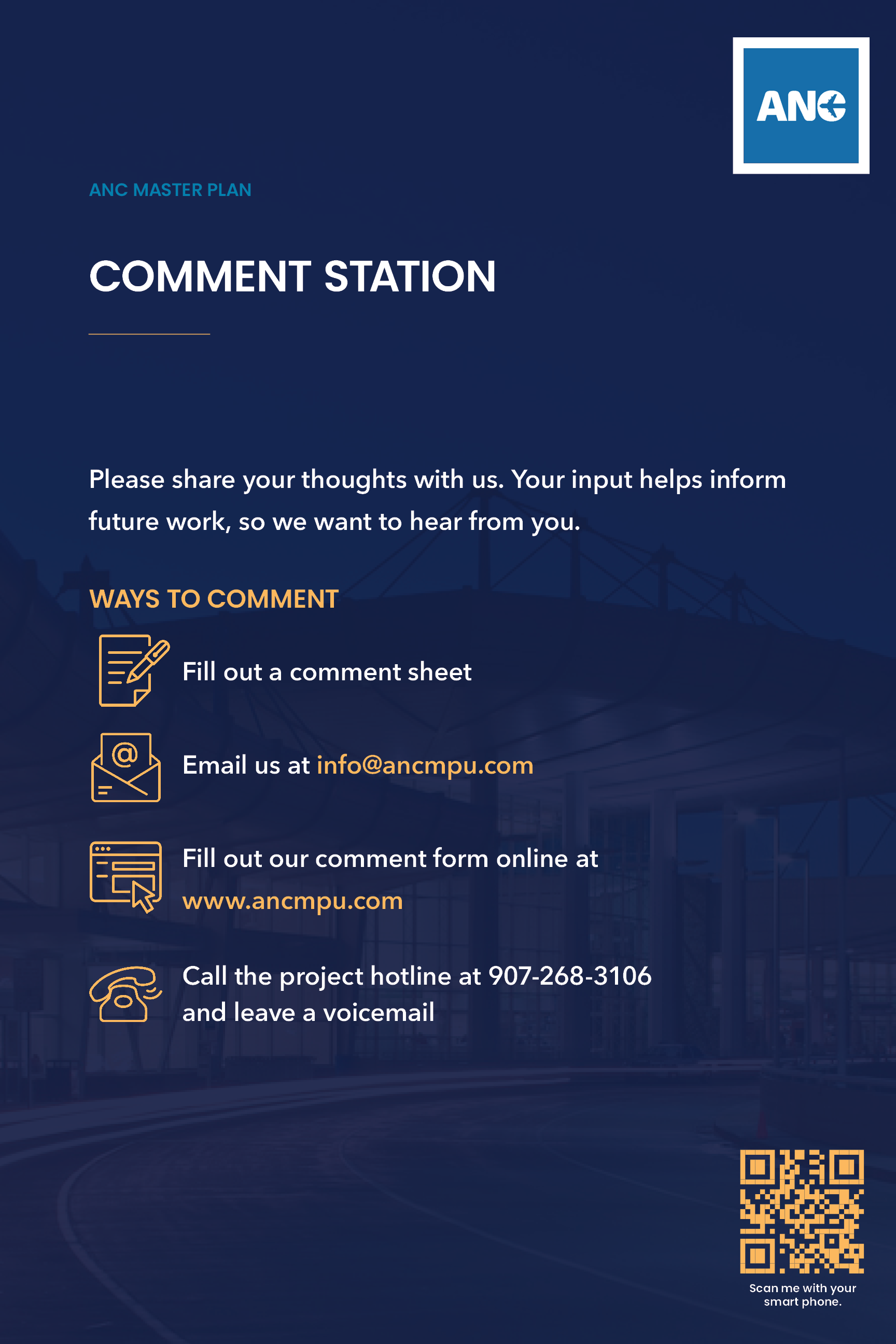Ted Stevens Anchorage International Airport Master Plan Update
**THE COMMENT PERIOD FOR THIS MEETING IS NOW CLOSED**
Welcome to the Anchorage Master Plan Online Public Meeting #4!
The purpose of this Online Public meeting is to share the materials that were presented at the May 29, 2024 in-person public meeting. This online platform is open from May 29 to June 12, 2024. Your feedback is important to us! You may visit the last station of this meeting or visit the website at ancmpu.com. You will also find documents presented at the in-person meeting linked below.
Navigating this site:
This site is best viewed on your desktop or laptop computer at 100% view. You may click the tabs in the left navigation to visit each poster station. You may click on each poster to enlarge it. If you prefer to experience this Online Meeting in text format only, visit the Text Only page of this meeting.
Welcome!
The ANC Master Plan Update (MPU)’s fourth and final public meeting will share preferred alternatives based off of aviation forecasts and facility requirements developed in fall 2023 and feedback from committee meetings and the public meeting in February 2024.
*** NOTE*** The NorthLink Project is a separate project working independently of the ANC MPU. For NorthLink questions, please contact the NorthLink Project team at 907-931-6350. Email them at: info@NorthLinkAviation.com or visit www.northlinkaviation.com.
Master Plan Process Overview & Schedule
The Master Plan Process Overview graphic starts with Study Design, which is completed. It then moves to the vision, goals, and objectives; forecast of aviation demand; and inventory of existing conditions. This group then leads to the FAA, then to facility requirements, then to alternatives development and evaluation, and then to “We are here” at finalize plan, which is split into the Capital Plan and Airport Layout Plan. Next is the FAA again, followed by the Master Plan being adopted. The final stage reads, “Prior to capital project implementation, environmental analysis and additional public involvement will be required under federal law. FAA (NEPA) [National Environmental Policy Act].”
The study took place in winter 2022. Project Foundation took place in May 2023, Visioning is taking place April 2023 to February 2024, and Implementation Planning occurs October 2023 to September 2024. Final Documentation will be prepared in the second half of 2024, and Public Involvement Opportunities started in November 2022 and will extend through the duration of the project. The MPU is projected to take about 28 months to complete, from September 2022 to December 2024.
Click the numbers below to learn about each phase of the Master Plan Process.
1
2
3
4
5
6
7
Study Design
We reviewed previous studies to develop a well-defined project approach that follows Federal Aviation Administration (FAA) guidance.
Vision, Goals & Objectives
Goals and objectives for the Master Plan Update were defined.
Aviation Forecast
Using feedback from the major airline stakeholders, the Master Plan team developed an Aviation Forecast of projections for passengers, cargo, and operations at ANC Airport. The forecast includes insight on future activity and was presented to the public in September 2023 public meeting after the data was accepted by the FAA.
Inventory
We updated any changes that have occurred since the previous Master Plan Update. Airport staff, tenants, and stakeholders helped identify changes in the existing conditions.
Facility Requirements
Facility requirements were determined primarily by technical analysis of existing facility data relative to forecast demand. For this Master Plan Update, facility requirements relied upon demand-level trigger points to establish a need for additional throughput capacity. A trigger point is the point at which throughput exceeds an established facility capacity, degrading facility performance or level of service and triggering a need for an improved or expanded facility. This stands in contrast to using a calendar to establish a timeline for facility improvements.
Alternatives Development & Evaluation
We prepared conceptual development plans that meet the established facility requirements. Typically, several solutions or alternatives are conceived to meet future facility needs.
The alternatives were screened using evaluation criteria to identify those that best meet the Airport’s needs. Multiple alternatives were then grouped into functional areas, refined, and combined based on feedback and scoring against the evaluation criteria. The refined, preferred alternative moved forward.
Finalize Master Plan Report
This is where we are currently in the schedule. The Facilities Implementation Plan provides recommendations on how to implement the Master Plan Update and the preferred alternative. This often includes a development schedule, cost estimates, phasing plan, identification of interrelated projects, and other special considerations. The Capital Plan will also be updated. To-scale Airport drawings that make up the Airport Layout Plan (ALP) will be updated, depicting proposed developments that are part of the selected alternative.
Master Plan Update conditions, findings, and development plans will be documented in a draft and a final report. The report will include a summary of public involvement activities and outcomes. It will also include a financial feasibility analysis for identified Airport improvements. The final report will be published and made available to the public.
Schedule
The Master Plan Update is anticipated to take roughly 28 months to complete, with a final completion date of December 2024. The schedule may change. The best way to stay up to date is to sign up for email updates.
Overall, public engagement and feedback have been positive. A recap of past meetings includes:
Public Meeting #1
Public Meeting #2
Public Meeting #3
Public Meeting #4
- 73 attendees
- 170 online open house visits
- 7 written comments
- 73 mailing list additions
- 29 attendees
- 44 online open house visits
- 4 written comments
- 29 mailing list additions
- 43 attendees
- 128 online open house visits
- 8 written comments
- 17 mailing list additions
We are here now. Meeting information will be updated after the online open house closes.
Goals & Objectives
The Goals and Objectives will be used to evaluate alternatives for meeting the primary purpose of the Master Plan Update: determining the best course of action for Airport development to meet future aviation demand.
The following goals were identified at the project’s outset in a staff and Airport leadership workshop and are strategically evolved from those in the prior Master Plan. Project goals are broad statements about what the Airport hopes to achieve through the Master Plan Update process.
Goals
- Safety
Maintain or enhance the safe operation of the Airport - Efficiency
Maintain or enhance the efficient operation of the Airport - Environmental Sustainability
Minimize the impact of Airport development through environmental awareness - Fiscal Sustainability
Maintain the long-term fiscal sustainability of the Airport - Land Management
Facilitate long-term Airport development through strategic land management planning - Communication
Engage stakeholders through open communication - Resilience
Minimize the impacts of operational interruptions and disruptions
Objectives
The objectives provide a framework for evaluating the Master Plan Update process and help determine if the project goals are met.
To view the full Goals and Objectives, scan the QR code with your smartphone or visit the supplemental information page.
Planning Activity Level (PAL)
Three planning activity levels (PAL) have been identified, each representing a milestone of growth in operations, passengers, cargo, and general aviation. Each PAL triggers required facility upgrades to accommodate growth and capacity. Capacity upgrades to facilities are based on PAL demand levels – not based on a date on a calendar.
Two graphs depict growth scenarios: In the forecasted growth scenario, growth occurs according to the forecast, and the example facility upgrade is triggered by the PAL 2 demand. Based on the demonstrated growth rate in this scenario, we know that PAL 2 occurs at the forecasted time. However, growth may occur faster or slower than forecast – this is why we use PALs to trigger facility capacity upgrades, not a calendar. For example, in the slower growth scenario, growth occurs more slowly than forecast and the example facility, so PAL 2 demand occurs later than forecast. Therefore, the example facility that is triggered by PAL 2 would not be required until a later time than originally forecast.
Supplemental Information
To view the full Facility Requirements, sisit the supplemental information page.
Aviation Forecast Baseline 2022
Baseline activity is actual activity that occurred in 2022.
Supplemental Information
To view the full Facility Requirements, sisit the supplemental information page.
Planning Activity Level (PAL) 1
A future date when demand for cargo, passenger, aircraft operations, and general aviation activities triggers a need.
Demand is based off findings from both the Aviation Forecast and Facility Requirements completed in fall 2023.
Forecast activity level at PAL 1:
- Annual Operations (takeoffs and landings): 251,000
- Annual Passenger Enplanements (boardings): 3.0 million
- Annual Cargo (landed weight): 4.2 million tonnes
- General Aviation Activity: 31,000 Operations (takeoffs and landings)
Supplemental Information
To view the full Facility Requirements, sisit the supplemental information page.
Planning Activity Level (PAL) 2
A future date when demand for cargo, passenger, aircraft operations, and general aviation activities triggers a need.
Demand is based off findings from both the Aviation Forecast and Facility Requirements completed in fall 2023.
Forecast activity level at PAL 2:
- Annual Operations (takeoffs and landings): 276,000
- Annual Passenger Enplanements (boardings): 3.4 million
- Annual Cargo (landed weight): 4.9 million tonnes
- General Aviation Activity: 32,000 Operations (takeoffs and landings)
Supplemental Information
To view the full Facility Requirements, sisit the supplemental information page.
Planning Activity Level (PAL) 3
A future date when demand for cargo, passenger, aircraft operations, and general aviation activities triggers a need.
Demand is based off findings from both the Aviation Forecast and Facility Requirements completed in fall 2023.
Forecast activity level at PAL 3:
- Annual Operations (takeoffs and landings): 326,000
- Annual Passenger Enplanements (boardings): 4.1 million
- Annual Cargo (landed weight): 6.2 million tonnes
- General Aviation Activity: 35,000 Operations (takeoffs and landings)
Supplemental Information
To view the full Facility Requirements, sisit the supplemental information page.
Alternatives Analysis Process
Alternatives are prepared to meet Facility Requirements and are then evaluated using an iterative process based on input from ANC staff, stakeholders, and the public. The process includes:
- Inventory & Aviation Forecast
- Facility Requirements
- Concepts
- Refining
- Preliminary Alternatives
- Decision
- Preferred Alternatives
We are currently within two stages: Stage 6 – Decision and Stage 7 – Preferred Alternatives.
Preferred Runway Overview
Phase 1: Minimize Development
This phase has been completed. Since 2014, ANC has improved existing ANC facilities to meet FAA Design Standards and enable tenant development as recommended in the 2014 Master Plan.
Phase 2: Optimize ANC
This phase is currently pending. Phase 2 optimizes the use of the existing ANC runways, improves the terminal and taxiways, and develops the West Airpark. The goal is to maximize the efficiency of the existing three-runway system at ANC.
Phase 3: Optimize Alaska International Airport System (AIAS)
This phase is for future growth. Phase 3 optimizes the use of both airports within the AIAS (Anchorage and Fairbanks Airports) to accommodate the higher demand levels. The goal is to maximize the efficiency of the entire AIAS system to make efficient use of existing airport infrastructure.
Phase 4: Additional Capacity at ANC or Elsewhere
This phase is for future growth. When demand reaches this point, Phase 4 will provide new runway capacity at ANC or at another Alaska airport to meet the highest levels of forecasted demand.
Airside – Cargo: Preferred Air Cargo Alternative
Demand for additional cargo aircraft parking will be met largely by tenant development and other planned cargo development.
Relocation of some Airport-managed cargo plane parking positions to the West Airpark may help alleviate airfield congestion.
Key features include:
- Existing “P” spots cargo parking (3 existing + 1 approved)
2. Existing “R” spots cargo parking (11)
3. Approved tenant cargo development in North Airpark
4. Approved tenant cargo development in South Airpark
5. Future West Airpark development areas
6. Area reserved for potential future airfield development
Preferred Terminal Alternative
Generally, the preferred alternative is for the passenger terminal complex to be expanded in three phases. This includes the following:
Phase 1: A&B Concourse Expansion:
This first phase expands the A Concourse and B Concourse to meet the PAL 1 demand.
Phase 2: C Concourse Expansion:
The second phase expands the C Concourse to meet the PAL 2 demand.
Phase 3: North Terminal Renovation:
The third phase renovates and expands the North Terminal to meet the PAL 3 demand.
PAL 1 – A + B Concourse Expansion
The Preliminary Terminal Alternative modifies the A Concourse and B Concourse to add one new gate and improve two existing gates, B10 and B11, and provide space inside the terminal to expand two areas that are at capacity by PAL 1: the security screening checkpoint and the outbound baggage make-up area.
PAL 1 – A Concourse Expansion
Preferred Terminal Alternative: A Concourse Expansion. The A Concourse serves regional airlines that serve Alaska communities. The preferred alternative includes an extension of the concourse that provides additional space for passengers to wait prior to boarding aircraft. A Concourse Expansion also includes:
- One reconfigured gate and two new gates
- Additional concession space
Preferred Terminal Alternatives: B Concourse Expansion
Preferred Terminal Alternative: B Concourse Expansion includes:
- Additional baggage processing capacity
- Relocated and improved concessions
- Increased circulation to reduce congestion
- Larger security checkpoint
- One new jet gate
- Two improved jet gates with larger hold rooms and new passenger boarding bridges
Preferred Terminal Alternatives: Conceptual Daytime Apron Usage
This alternative includes flexible aircraft parking that would accommodate regional airlines during daytime hours and mainline airlines during nighttime hours. During the day, regional aircraft would park on the apron and use Gate L1 on the lower level of the terminal. The conceptual daytime apron usage for the B Concourse Apron is the following:
- Gate B1 for one Boeing 737-900 (ADG-III)
- Gates B10 and B11 for two Dash-8 Series 400 (ADG-III)
- Gate L2 for one Saab-2000 (ADG-III)
- Gates A10–A18 for a maximum of nine Dash-8 Series 100 (ADG-III), a maximum of nine Beechcraft 1900D (ADG-II), or a combination of both
Preferred Terminal Alternatives: Conceptual Nighttime Apron Usage
During the evening, Gates B10 and B11 would accommodate larger jet aircraft from a mainline airline. The conceptual daytime apron usage for the B Concourse Apron is the following:
- Gates B1, B10, and B11 for three Boeing 737-900 (ADG-III)
- Gate L2 for one Saab-2000 (ADG-III)
- Gates A10–A18 for a maximum of nine Dash-8 Series 100 (ADG-III), a maximum of nine Beechcraft 1900D (ADG-II), or a combination of both
Preferred Terminal Alternative Overview (PAL 2/3)
PAL 2 and 3 include:
- Reconfiguration and improvement of the existing eight North Terminal gates and potential for three additional jet gates on a new connector between the existing C Concourse and North Terminal.
- Enhanced utilization of the existing North Terminal and full connection to the existing South Terminal.
- Improvements that enable maximum flexibility and accommodate additional growth in airline service at ANC.
Preferred Terminal Alternative – Rough Order of Magnitude Cost Summary Concourse Expansion
A rough order of magnitude cost estimate was performed on all terminal alternatives. Costs include vertical building work and apron civil work. Contingency is included to account for planning-level ROM cost. Soft costs include design, permitting, and construction administration. Costs are escalated to 2027 dollars.
A Concourse Expansion
- Construction items: $11.4M – 14.0M
- Soft Costs: $9.0M – 11.1M
- Total Cost: $20.4M – 25.1M
B Concourse Expansion
- $122.1M – 149.4M
- $81.8M – 100M
- $203.9M – 249.4M
C Concourse Expansion
- $132.7 – 162.3M
- $93.7M – 114.7M
- $226.4M – 277.0M
North Terminal Expansion
- $190.6M – 233.0M
- $175.6 – 214.7M
- $366.2M – 447.7M
A + B Concourse Total = $224.3M – 274.5M
C Concourse + North Terminal Total = $592.6M – 724.7M
Preferred Landside Alternative
New Parking Garage, ATCT Site (FAA is in the design phase for a new tower at ANC and will demolish the existing tower in the next 2 to 4 years):
- three levels
- 1,200 stalls (220 net stall count)
New Garage, Lot F Site:
- three levels
- 1,200 stalls (885 net stall count)
Lot Expansion of Park, Ride & Fly
- 220 stalls (220 net stall count)
New Surface Lot, East Airpark
- 700 stalls (700 net stall count)
Preferred Landside Alternative – Rough Order of Magnitude Summary
A rough order of magnitude cost estimate was performed on preferred landside alternatives. Parking garage construction costs (prior to soft costs) assume $75,000/stall. Contingency is included to account for planning-level ROM cost. Soft costs include design, permitting, and construction administration. Costs are escalated to 2027 dollars.
New Parking Garage: ATCT Site
- Construction Items: $112.5M – 137.6M
- Soft Costs: $45.4M – 55.6M
- Total Costs: $157.9M – 193.2M
- Net Stall Count: 1,200
- Cost/Stall: $132K – 161K per stall
New Parking Garage: Lot F Site
- Construction Items: $115.8M – 141.6M
- Soft Costs: $46.7M – 57.2M
- Total Costs: $162.5M – 198.8M
- Net Stall Count: 885
- Cost/Stall: $184K – 225K per stall
Lot Expansion: Park, Ride & Fly
- Construction Items: $5.1M – 6.4M
- Soft Costs: $2.0M – 2.6M
- Total Costs: $7.1M – 9.0M
- Net Stall Count: 220
- Cost/Stall: $32K – 41K per stall
New Lot in East Airpark
- Construction Items: $17.2M – 21.1M
- Soft Costs: $5.3M – 6.6M
- Total Costs: $22.5M – $27.7M
- Net Stall Count: 700
- Cost/Stall: $32K – 40K per sta
Preferred Support Facilities Alternative – South Airpark
Key features of this alternative include:
- Future Taxiway Z alignment:
- The Taxiway Z extension impacts an existing firearms training facility in the South Airpark.
- Future corporate and general aviation development area.
- Additional general aviation development areas.
Comments
Please share your thoughts with us. Your input helps inform future work.
Ways to Comment:
• Fill out a comment sheet
• Email us at info@ancmpu.com
• Fill out our comment form online at ancmpu.com
• Call the project hotline at 907-268-3106 and leave a voicemail
Meeting Materials
Each of the documents below is a downloadable PDF file. You will need Adobe Acrobat Reader to view the documents. If you do not have Adobe Acrobat Reader, you may download a free version from https://get.adobe.com/reader.

